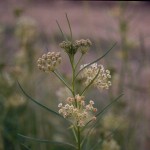Horsetail Milkweed
Asclepias subverticillata
Asclepiadaceae
Description
Horsetail Milkweed is an erect stemmed plant growing mainly in West Texas from a stout, woody rootstock reaching 4 ft or 120 cm tall. It often grows in large stands. This plant may have multiple branches or be unbranched. The narrow, <5 mm, dark green leaves reach up to 13 cm, are in whorls of three or paired opposite, and have margins rolled backward. The sub-sessile lance-shaped leaves are alternate and acute at both apex and base The greenish-white star-like flowers give rise to pods 6 to 12 cm long from May to September. Seeds have tufts of long silky hairs.Habitat
Abundant in West Texas, this plant has also been recorded in the South Texas Plains and Gulf Coast Prairie regions. It is common in northern Mexico and ranges into Arizona, Colorado, and Utah. It often abounds in open pastures and along arroyos, draws, trails, roadsides, and bar ditches.Toxic Agent
This plant is among the most toxic to livestock of any of the milkweed species. The toxic agent involved is suspected to be the resinoid galitoxin. Horsetail Milkweed has poisoned sheep, cattle, horses, chickens, and turkeys. To ingest a toxic dose, an animal generally must eat 0.2 percent of its body weight in green plant material. A sheep may be killed by eating 2 to 3 ounces.Signs of Livestock Ingestion
The signs produced by whorled species of Asclepias are different from those produced by other milkweeds. Effects are on the nervous system rather than the cardiac system. They include: Staggering, incoordination, excitement; Head tremors, muscle tremors, convulsions; Star-gazing posture; Depression, labored breathing, dilated pupils, and progressing to death. Clinical signs appear within a few hours of ingestion of a toxic dose, and death follows from one to a few days in most fatal cases.Management Strategies
Animals dislike the taste of milkweeds and seldom graze them unless they are confined to milkweed-infested areas. Most losses result from overgrazing and drought. The plants are most toxic before maturing; somewhat less so as they dry. Horsetail Milkweed retains enough toxicity to be dangerous in hay. Although most animals die after reaching the convulsive stage of milkweed poisoning, some recover. Move poisoned individuals to shade, keep them quiet, and give them plenty of food and water. No medicinal treatment is specified, but sedatives, laxatives, and intravenous fluids may help.Images
Plant Characteristics
Flower Color: Green, White
Seed Type: Bean/Pod
Duration: Perennial
Stem Texture: Hairless/Smooth
Growth Habit: Forbs/Broadleaf
Leaf Shape
 : Simple with Pinnate or Parallel Venation
: Simple with Pinnate or Parallel Venation
Season: Warm
Distribution
 : 07 - Edwards Plateau, 08 - Rolling Plains, 09 - High Plains, 10 - Trans-Pecos
: 07 - Edwards Plateau, 08 - Rolling Plains, 09 - High Plains, 10 - Trans-Pecos
Distributions
Distribution refers to the ecological region in Texas that a plant has been found. You can also view a clickable map.
Book: Toxic Plants of Texas (B-6105)
Collection: Toxics, Wild Flowers
Livestock Affected: Cattle, Goats, Horses, Poultry, Sheep
Livestock Signs: Abnormal Heartbeat, Collapse, Coma, Convulsions, Depression/ Weakness, Dilated Pupils, Excess Salivation, Incoordination, Irregular Breathing






